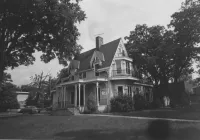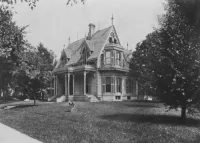Share what you know,
and discover more.
Share what you know,
and discover more.
Jun 01, 1984

B.O. Cutter house, Fourth Street and Tenth Avenue Southeast, Minneapolis
B.O. Cutter House on the University of Minnesota campus. Picture from approximately 1984 Photographer: Gordon Ray
Jun 01, 1984
B.O. Cutter house, Fourth Street and Tenth Avenue Southeast, Minneapolis
B.O. Cutter House on the University of Minnesota campus. Picture from approximately 1984Photographer: Gordon Ray
Posted Date
Feb 23, 2022
Historical Record Date
Jun 01, 1984
Source Name
Minnesota Historical Society
Delete Story
Are you sure you want to delete this story?
Jan 30, 1976
Jan 30, 1976

-

- Dave D
B.O. Cutter house - National Register of Historic Places
STATEMENT OF SIGNIFICANCE The B.O. Cutter House is both an historically and architecturally significant building in the City of Minneapolis. Architecturally, it is an excellent example of the Gothic Cottage style which flourished in Minnesota during the mid-nineteenth century. Its high-pitched roof, elaborate bargeboard decoration, and delicately arched porches are characteristic of early Gothic Revival architecture. It is also architecturally important because it is the only remaining Gothic Cottage in the Twin Cities area. Built by master-carpenter, B.O. Cutter, the house is historically significant as an example of his craftsmanship and his home, and later as the home of one of Minneapolis' prominent citizens, John B. Gilfillan. Cutter came to Minneapolis from the East in the 1850s to work with Robert S. Alden, Minneapolis' first resident architect. As Alden's partner. Cutter was the master-carpenter for the early buildings at the University of Minnesota. In this capacity, he greatly influenced the early physical appearance of the University. In 1869 Cutter sold the house to John B. Gilfillan, a distinguished Minneapolis lawyer, Gilfillan, like several other prominent mid-19th century Minnesota lawyers and community leaders - William G. LeDuc, lawyer and proprietor of St. Paul's first bookstore; Eugene St. Julien Cox, lawyer, orator and judge; and Henry Nichols, a scholarly Presbyterian minister - chose a Gothic Revival house for his home. The individuality and adaptability of the style, as well as its harmonious blending with nature greatly appealed to these early frontier leaders. In addition to being a successful lawyer in Minneapolis, Gilfillan also is credited with founding the city's elementary school system. He served as a Regent of the University of Minnesota and in the U.S, Congress for one term. He ' also was Judge of the District Court and President of the First National Bank of Minneapolis. Throughout his life Gilfillan served the City of Minneapolis admirably. The B.O. Cutter house is thus a fine example of early Gothic Cottage architecture and reflects the romanticism and high ideals of its builder, B.O. Cutter, and its early owner, John B, Gilfillan.
B.O. Cutter house - National Register of Historic Places
STATEMENT OF SIGNIFICANCE The B.O. Cutter House is both an historically and architecturally significant building in the City of Minneapolis. Architecturally, it is an excellent example of the Gothic Cottage style which flourished in Minnesota during the mid-nineteenth century. Its high-pitched roof, elaborate bargeboard decoration, and delicately arched porches are characteristic of early Gothic Revival architecture. It is also architecturally important because it is the only remaining Gothic Cottage in the Twin Cities area. Built by master-carpenter, B.O. Cutter, the house is historically significant as an example of his craftsmanship and his home, and later as the home of one of Minneapolis' prominent citizens, John B. Gilfillan. Cutter came to Minneapolis from the East in the 1850s to work with Robert S. Alden, Minneapolis' first resident architect. As Alden's partner. Cutter was the master-carpenter for the early buildings at the University of Minnesota. In this capacity, he greatly influenced the early physical appearance of the University. In 1869 Cutter sold the house to John B. Gilfillan, a distinguished Minneapolis lawyer, Gilfillan, like several other prominent mid-19th century Minnesota lawyers and community leaders - William G. LeDuc, lawyer and proprietor of St. Paul's first bookstore; Eugene St. Julien Cox, lawyer, orator and judge; and Henry Nichols, a scholarly Presbyterian minister - chose a Gothic Revival house for his home. The individuality and adaptability of the style, as well as its harmonious blending with nature greatly appealed to these early frontier leaders. In addition to being a successful lawyer in Minneapolis, Gilfillan also is credited with founding the city's elementary school system. He served as a Regent of the University of Minnesota and in the U.S, Congress for one term. He ' also was Judge of the District Court and President of the First National Bank of Minneapolis. Throughout his life Gilfillan served the City of Minneapolis admirably. The B.O. Cutter house is thus a fine example of early Gothic Cottage architecture and reflects the romanticism and high ideals of its builder, B.O. Cutter, and its early owner, John B, Gilfillan.
B.O. Cutter house - National Register of Historic Places
STATEMENT OF SIGNIFICANCEThe B.O. Cutter House is both an historically and architecturally significant building in the City of Minneapolis. Architecturally, it is an excellent example of the Gothic Cottage style which flourished in Minnesota during the mid-nineteenth century. Its high-pitched roof, elaborate bargeboard decoration, and delicately arched porches are characteristic of early Gothic Revival architecture. It is also architecturally important because it is the only remaining Gothic Cottage in the Twin Cities area.
Built by master-carpenter, B.O. Cutter, the house is historically significant as an example of his craftsmanship and his home, and later as the home of one of Minneapolis' prominent citizens, John B. Gilfillan. Cutter came to Minneapolis from the East in the 1850s to work with Robert S. Alden, Minneapolis' first resident architect. As Alden's partner. Cutter was the master-carpenter for the early buildings at the University of Minnesota. In this capacity, he greatly influenced the early physical appearance of the University.
In 1869 Cutter sold the house to John B. Gilfillan, a distinguished Minneapolis lawyer, Gilfillan, like several other prominent mid-19th century Minnesota lawyers and community leaders - William G. LeDuc, lawyer and proprietor of St. Paul's first bookstore; Eugene St. Julien Cox, lawyer, orator and judge; and Henry Nichols, a scholarly Presbyterian minister - chose a Gothic Revival house for his home. The individuality and adaptability of the style, as well as its harmonious blending with nature greatly appealed to these early frontier leaders.
In addition to being a successful lawyer in Minneapolis, Gilfillan also is credited with founding the city's elementary school system. He served as a Regent of the University of Minnesota and in the U.S, Congress for one term. He ' also was Judge of the District Court and President of the First National Bank of Minneapolis. Throughout his life Gilfillan served the City of Minneapolis admirably.
The B.O. Cutter house is thus a fine example of early Gothic Cottage architecture and reflects the romanticism and high ideals of its builder, B.O. Cutter, and its early owner, John B, Gilfillan.
Posted Date
Feb 23, 2022
Historical Record Date
Jan 30, 1976
Source Name
United States Department of the Interior - National Parks Service
Delete Story
Are you sure you want to delete this story?
Jun 01, 1890
Jun 01, 1890
400 10th Avenue Southeast, Minneapolis, MN, USA
B.O. Cutter House - picture taken circa 1890Posted Date
Feb 23, 2022
Historical Record Date
Jun 01, 1890
Source Name
Minnesota Historical Society
Delete Story
Are you sure you want to delete this story?











